Attainable Moment Set Optimization to Support Configuration Design: A Required Moment Set Based Approach
Abstract
Featured Application
Abstract
1. Introduction
2. Methodology Overview
2.1. Theoretical Background
- Control Space: A Cartesian coordinate system in the space, with one control effector as a variable on each axis. is the number of effectors. Each point in this space represents a combination of effector positions.
- Admissible Control Set: (): A set in the control space of all possible combinations of effector positions given their respective limits. Since the effectors are actuated independently, it figures a cuboid or hyper-cuboid in the control space.
- Moment Space: A Cartesian coordinate system in the space, with generalized forces on each axis as variables. The generalized forces do not necessarily have to be moments but also, e.g., angular accelerations, load factors or direct forces. The name “Moment Space” is more of a legacy concept at its initial definition. is the number of generalized forces.
- Attainable Moment Set: (): A set in the moment space of all possible combinations of generalized forces that can be produced from the effector combinations in the ACS. In this paper, we consider a linear mapping from ACS to AMS, with the so-called effectiveness matrix . Since is convex, this convexity is preserved by this linear transformation [10], making the AMS geometrically a convex polytope in the moment space. The matrix is inherently defined by the configuration especially the effectors, e.g., the moments produced by a propeller is dependent on its lever arm with respect to center of gravity and the angle of installation.
- Required Moment Set: A set in the moment space, incorporating all the combination of generalized forces desired to fulfill the prescribed system requirements and missions. These requirements and missions could include fulfillment of certain trajectory profiles, bandwidths of control reaction or disturbance rejections. The RMS is inherent from major system parameters such as mass and moment of inertia, as well as the prescribed requirements, and will remain unchanged once the concept of operations and preliminary design are fixed.
2.2. Calculation of AMS and RMS
2.3. The Optimization Framework
3. Optimization Formulation
- is the vector from origin to the i-th RMS vertex,
- is the intersection point of a ray extension from onto the AMS’s boundary,
- is the 2-norm of a vector.

- is the total number of vertices on the RMS,
- is the vector of variables to optimize, with and the lower and upper bounds of ,
- is the vector of some additional constraints, e.g., allowance of additional mass or space, with is the limits of .
4. Efficient Intersection Solver
- 1.
- After rotation, only facets in the positive-x half (rotated) space can be the intersection facet, meaning the number of search facets is reduced by approximately half.
- 2.
- The intersection facet contains the origin in the rotated y-z plane, meaning the 3 vertices of the facet can only be of one of the following 3 cases:
- ◦
- lie in 3 different quadrants of the y-z plane,
- ◦
- only lie in quadrants 1 and 3 in the y-z plane,
- ◦
- only lie in quadrants 2 and 4 in the y-z plane.
- 3.
- The fixation for the intersection facet reduces to a 2 “point-in-triangle” problem—the three vertices of the intersection facet must enclose origin in the y-z plane.
- 4.
- Once the facet is found, the final solution can be found by ray tracing.

4.1. Coordinate Transformation
4.2. Origin-in-Triangle Check

4.3. Ray Tracing for Intersection
5. Implementation and Results
5.1. The Plant Model and the Moment Sets
5.2. Verification of Intersection Solver
5.3. Single Variable Optimization
5.4. Multivariable Optimization
6. Conclusions
Author Contributions
Funding
Institutional Review Board Statement
Informed Consent Statement
Data Availability Statement
Conflicts of Interest
References
- Durham, W.C. Constrained control allocation. J. Guid. Control Dyn. 1993, 16, 717–725. [Google Scholar] [CrossRef]
- Durham, W.C. Constrained control allocation—Three-moment problem. J. Guid. Control Dyn. 1994, 17, 330–336. [Google Scholar] [CrossRef]
- Varriale, C.; Voskuijl, M.; Veldhuis, L.L. Trim for Maximum Control Authority Using the Attainable Moment Set. In AIAA Scitech 2020 Forum, 2020/01/05; American Institute of Aeronautics and Astronautics: Reston, VA, USA, 2020; ISBN 9781624105951. [Google Scholar]
- Nguyen Van, E.; Troillard, P.; Jézégou, J.; Alazard, D.; Pastor, P.; Döll, C. Reduction of Vertical Tail Using Differential Thrust: Influence on Flight Control and Certification. In Proceedings of the Advanced Aircraft Efficiency in a Global Air Transport System (AEGATS’18), Toulouse, France, 23–25 October 2018; pp. 1–8. [Google Scholar]
- Van, E.N.; Alazard, D.; Döll, C.; Pastor, P. Co-design of aircraft vertical tail and control laws using distributed electric propulsion. IFAC PapersOnLine 2019, 52, 514–519. [Google Scholar] [CrossRef]
- Moore, K.R.; Ning, A. Distributed Electric Propulsion Effects on Existing Aircraft through Multidisciplinary Optimization. In 2018 AIAA/ASCE/AHS/ASC Structures, Structural Dynamics, and Materials Conference; American Institute of Aeronautics and Astronautics: Reston, VA, USA, 2018; ISBN 978-1-62410-532-6. [Google Scholar]
- Pei, J.; Bassett, G.; Grisham, J.; Finch, P.; Toniolo, M.; Miller, L.; Bandu, P. Generic Control Allocation Toolbox for Preliminary Vehicle Design. In 2018 Modeling and Simulation Technologies Conference, Reston, Virginia; American Institute of Aeronautics and Astronautics: Reston, VA, USA, 2018; ISBN 9781624105517. [Google Scholar]
- Söpper, M.; Zhang, J.; Holzapfel, F. Required Moment Sets: Enhanced Controllability Analysis for Nonlinear Aircraft Models. Appl. Sci. 2021, submitted. [Google Scholar]
- Durham, W.; Bordignon, K.A.; Beck, R. Aircraft Control Allocation; Wiley: Chichester, UK, 2017; ISBN 9781118827796. [Google Scholar]
- Bordignon, K.A. Constrained Control Allocation for Systems with Redundant Control Effectors; Virginia Tech: Blacksburg, VA, USA, 1996. [Google Scholar]
- The Mathworks, Inc. MATLAB Version: 9.8.0.1451342 (R2020a); The Mathworks, Inc.: Natick, MA, USA, 2020. [Google Scholar]
- Barber, C.B.; Dobkin, D.P.; Huhdanpaa, H. The quickhull algorithm for convex hulls. ACM Trans. Math. Softw. 1996, 22, 469–483. [Google Scholar] [CrossRef]
- Johansen, T.A.; Fossen, T.I. Control allocation—A Survey. Automatica 2013, 49, 1087–1103. [Google Scholar] [CrossRef]
- Bodson, M. Evaluation of Optimization Methods for Control Allocation. J. Guid. Control Dyn. 2002, 25, 703–711. [Google Scholar] [CrossRef]
- Foley, J.D.; Van, F.D.; van Dam, A.; Feiner, S.K.; Hughes, J.F.; Angel, E.; Hughes, J. Computer Graphics: Principles and Practice; Addison-Wesley Professional: Boston, MA, USA, 1996; ISBN 9780201848403. [Google Scholar]
- Mebius, J.E. Derivation of the Euler-Rodrigues formula for three-dimensional rotations from the general formula for four-dimensional rotations. arXiv 2007, arXiv:math/0701759. [Google Scholar]
- Mahony, R.; Kumar, V.; Corke, P. Multirotor Aerial Vehicles: Modeling, Estimation, and Control of Quadrotor. IEEE Robot. Autom. Mag. 2012, 19, 20–32. [Google Scholar] [CrossRef]
- Riether, F. Agile Quadrotor Maneuvering Using Tensor-Decomposition-Based Globally Optimal Control and Onboard Visual-Inertial Estimation; Massachusetts Institute of Technology: Cambridge, MA, USA, 2016. [Google Scholar]
- Härkegård, O. Quadratic Programming Control Allocation Toolbox for Matlab (Version 1.2.1). 2004. Available online: http://research.harkegard.se/qcat/ (accessed on 1 February 2021).
- Dantzig, G.; Orden, A.; Wolfe, P. The generalized simplex method for minimizing a linear form under linear inequality restraints. Pac. J. Math. 1955, 5, 183–195. [Google Scholar] [CrossRef]
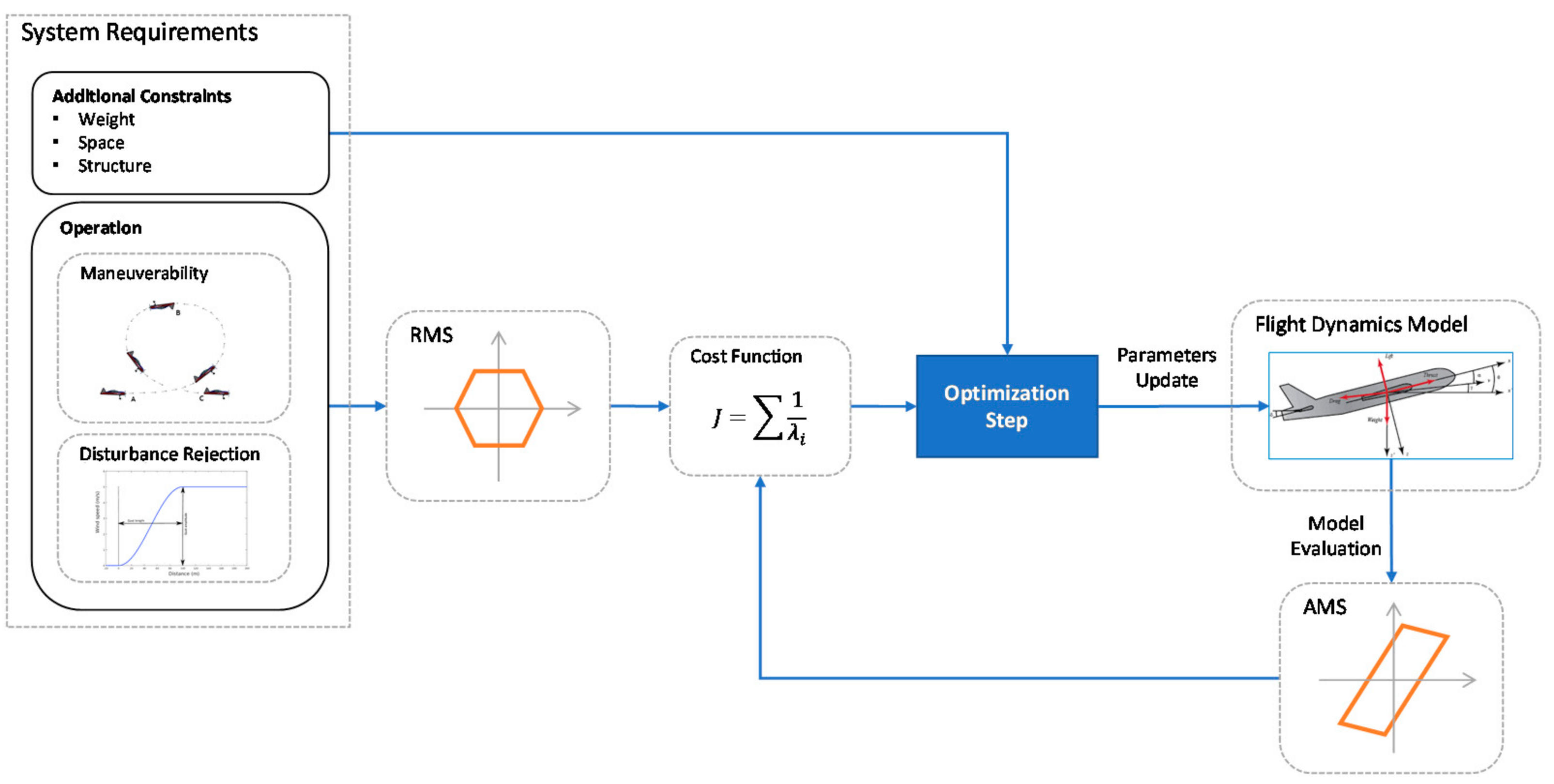

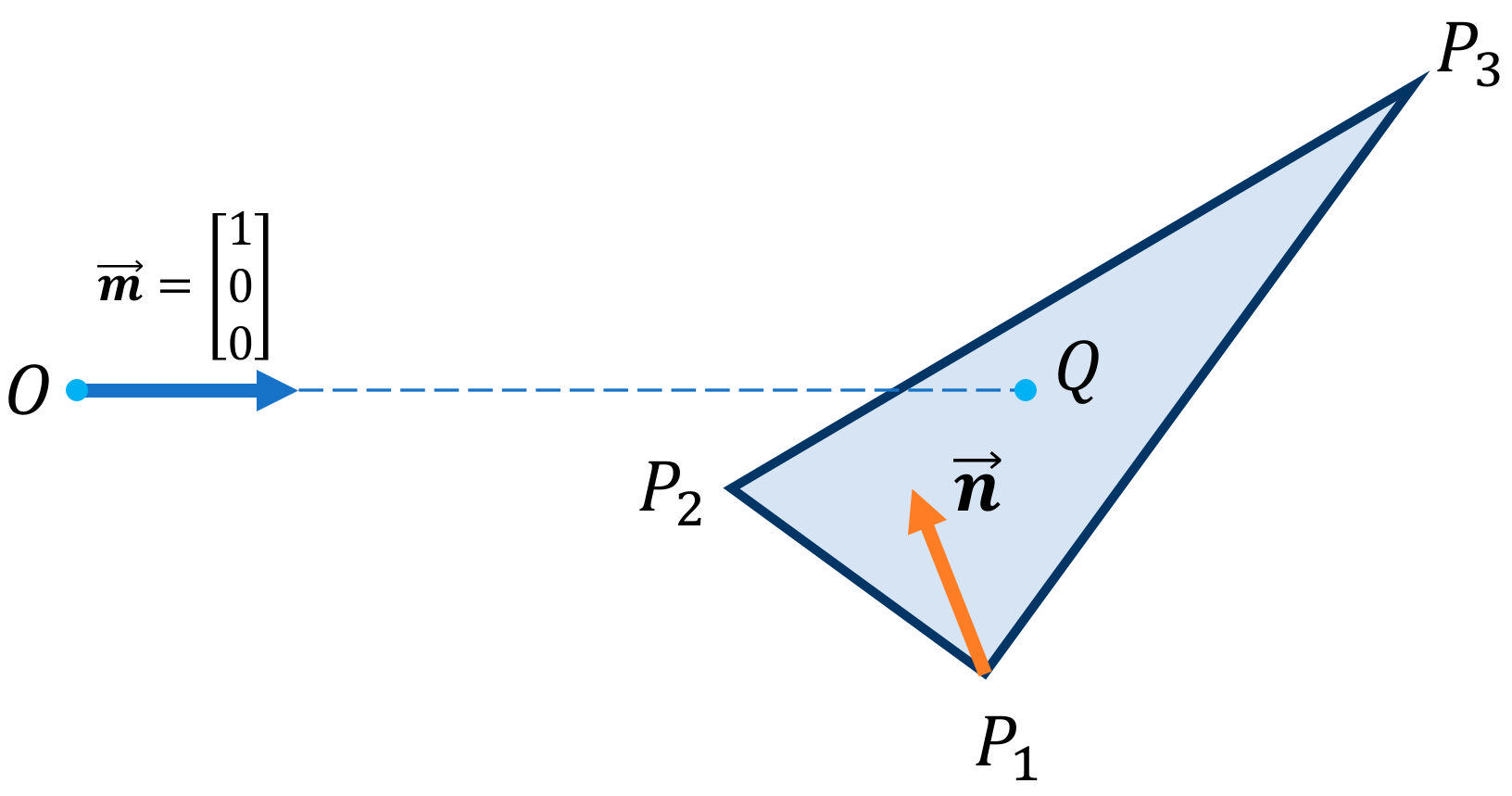
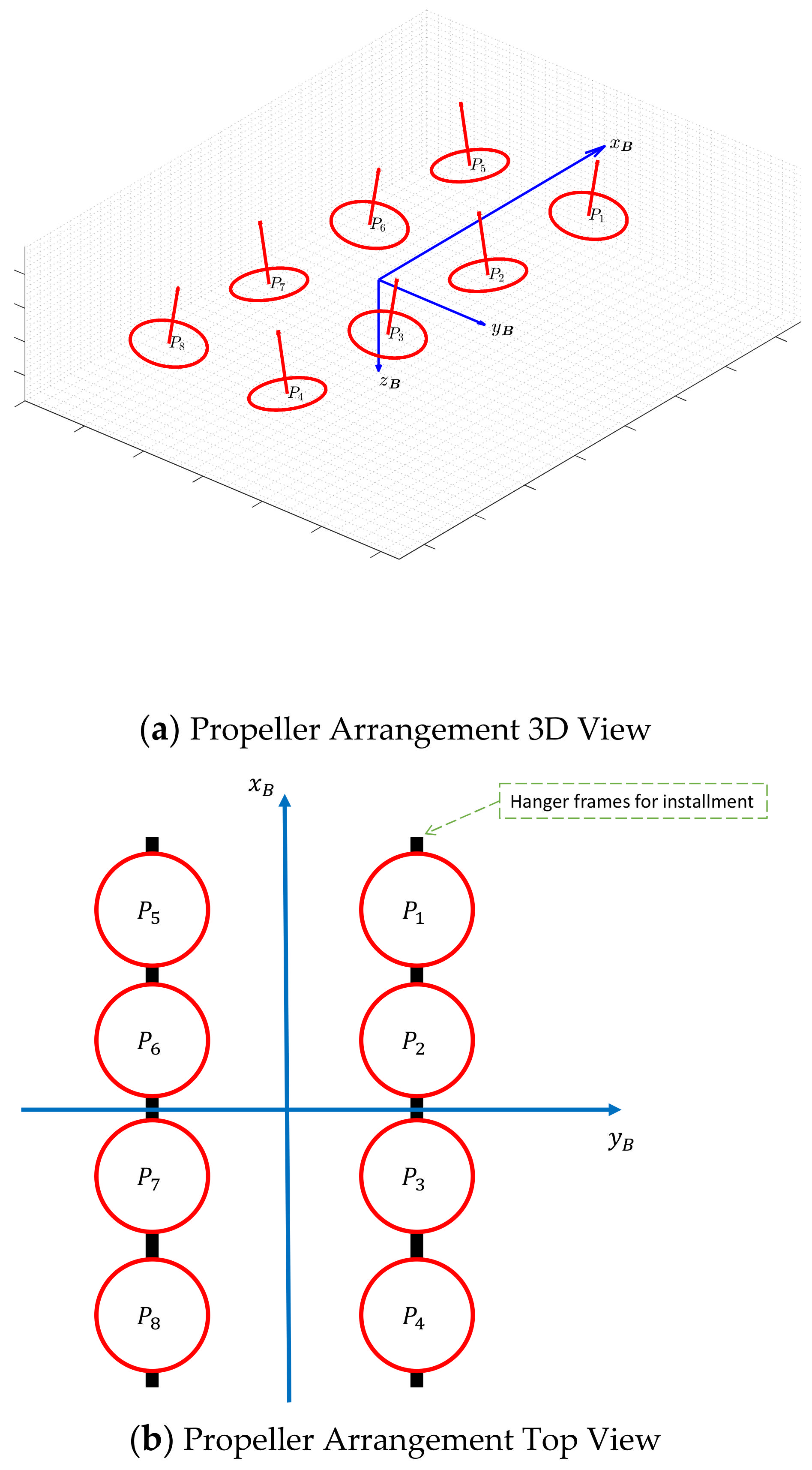

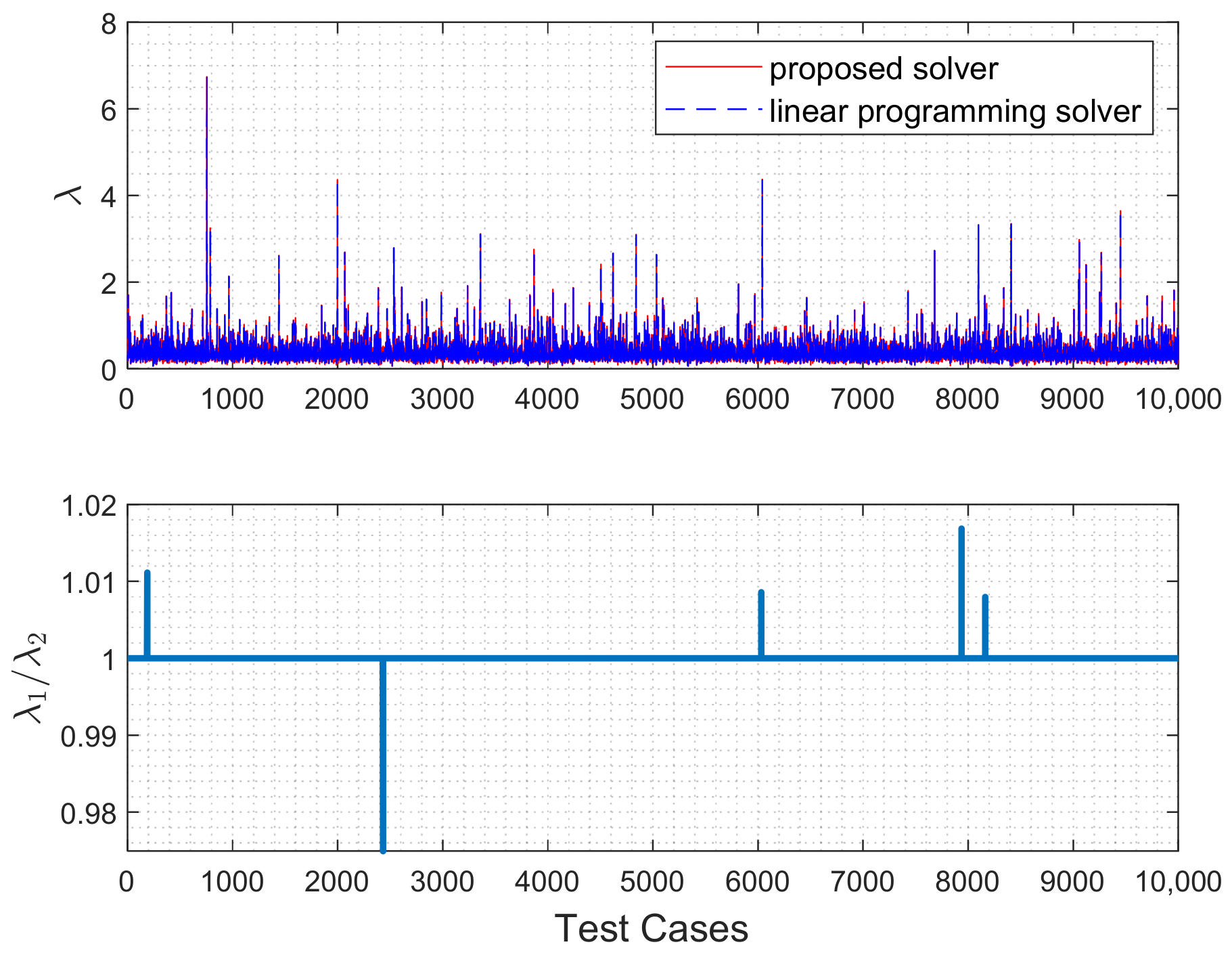
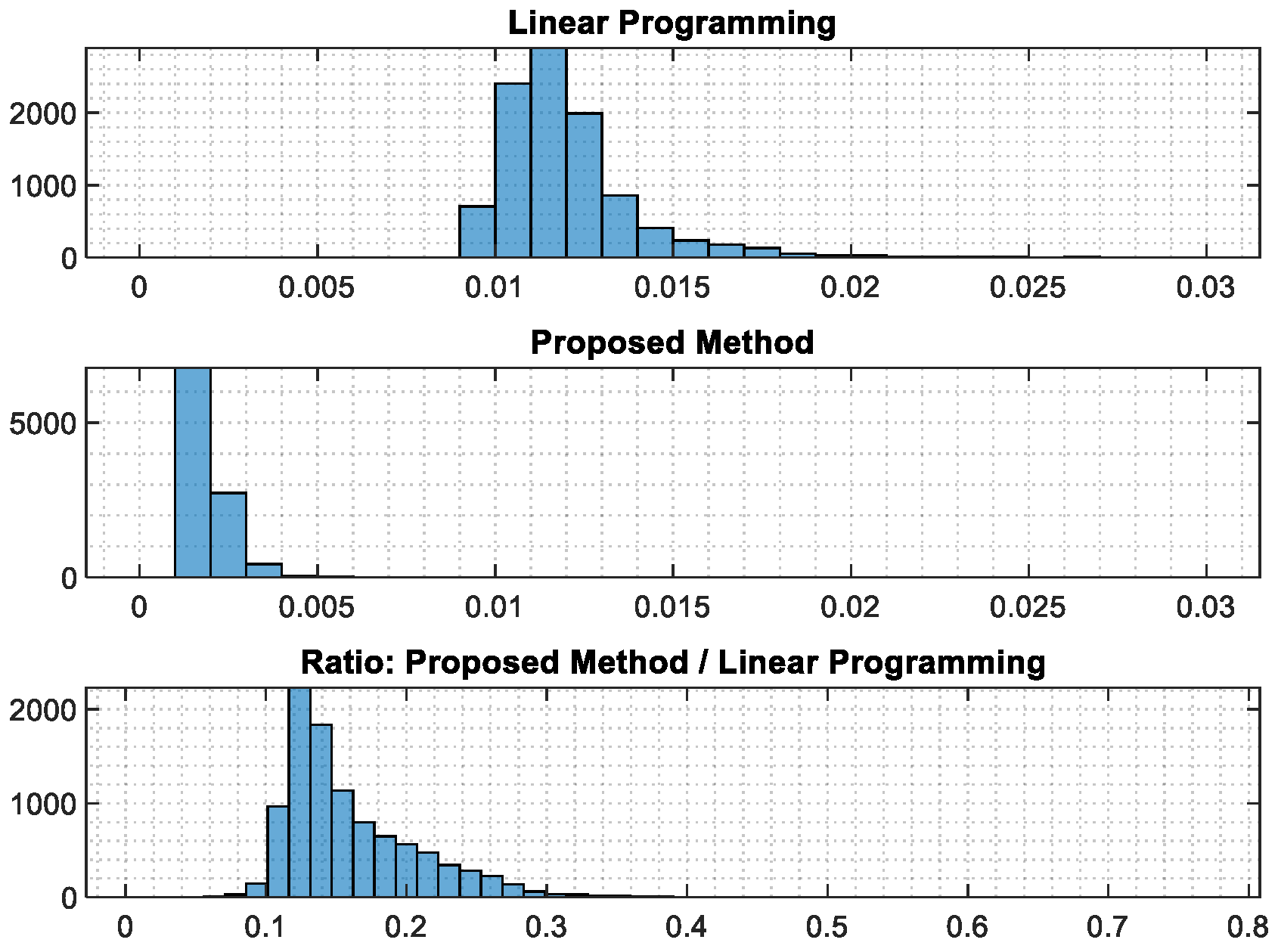
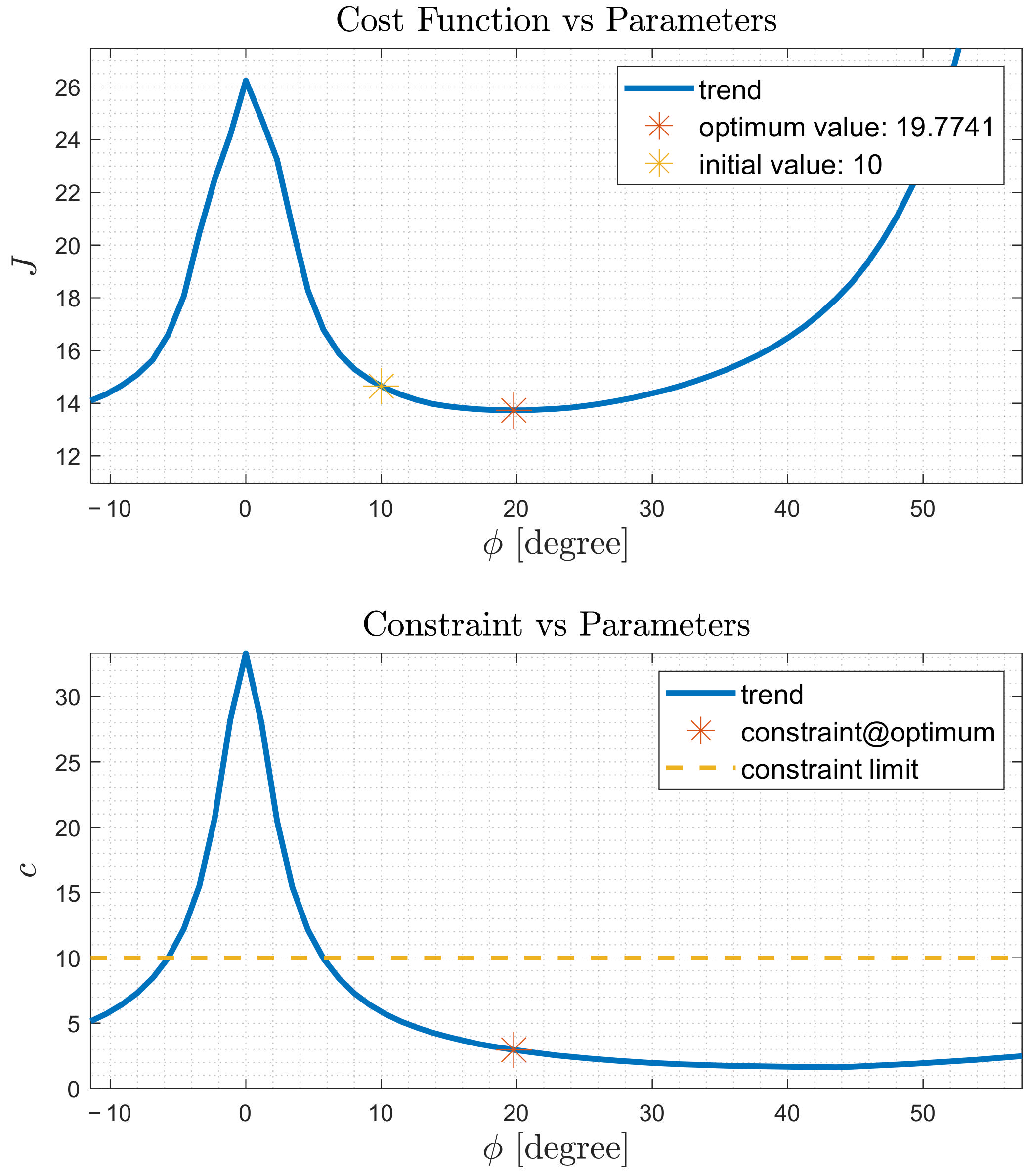
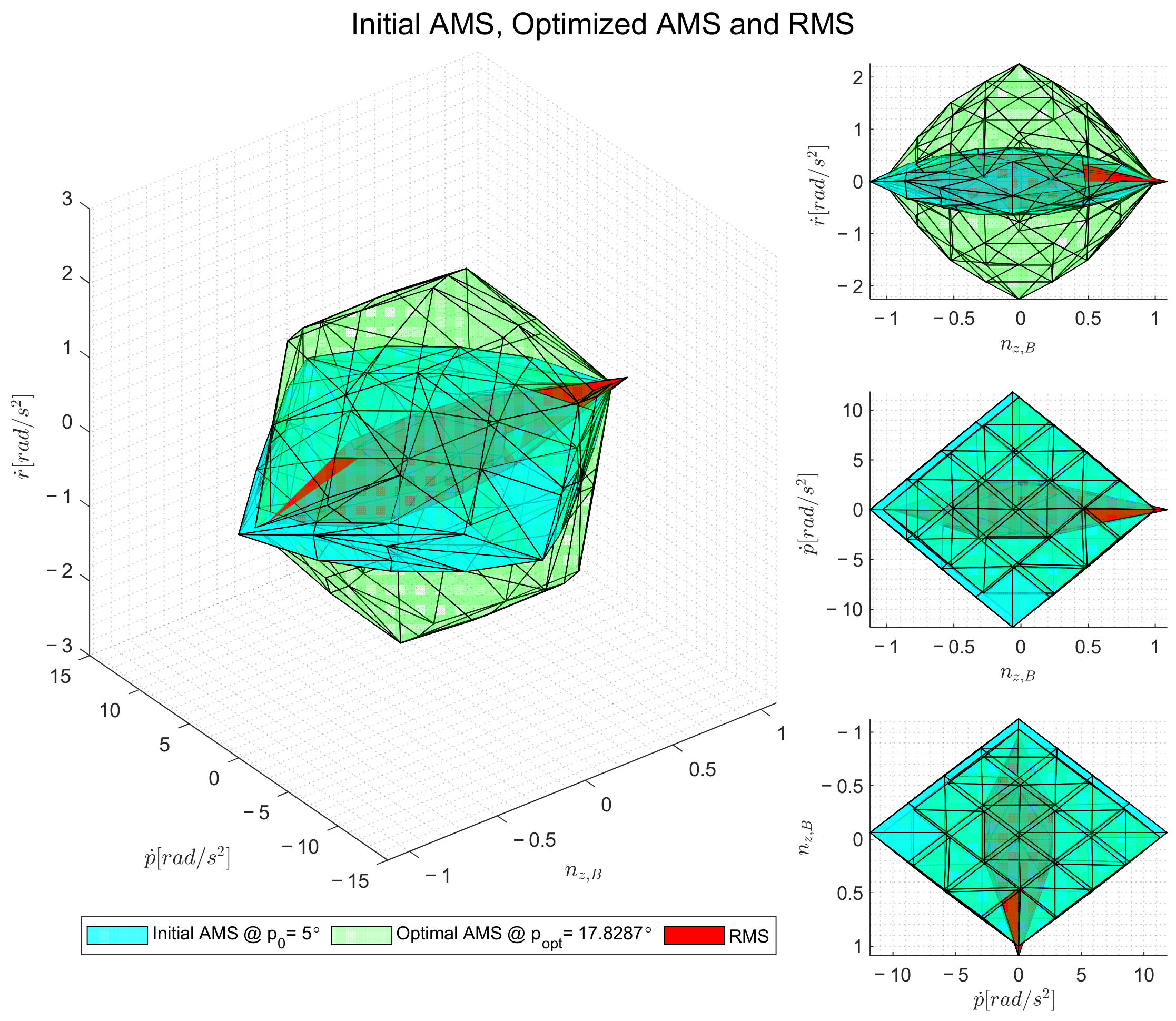

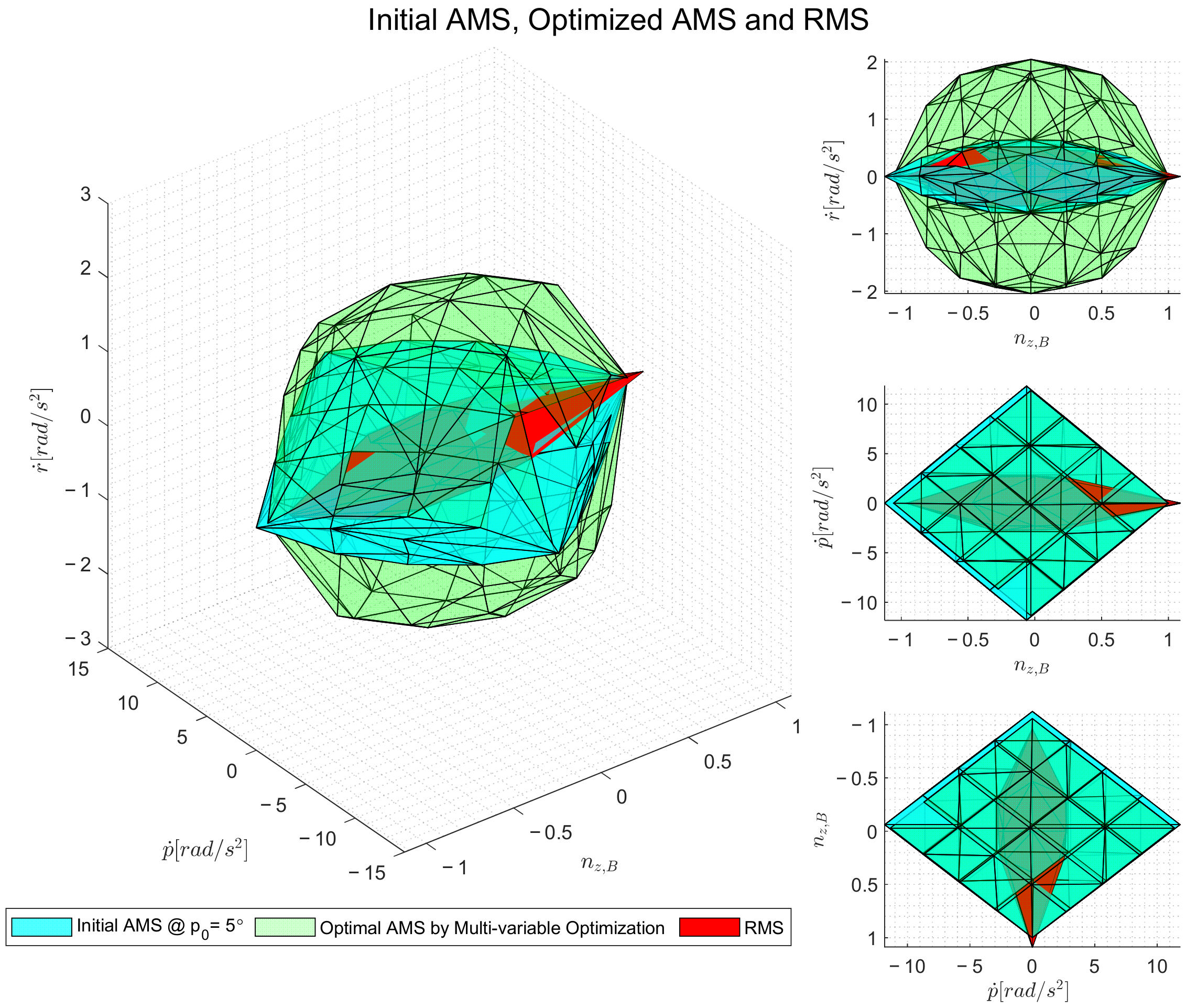
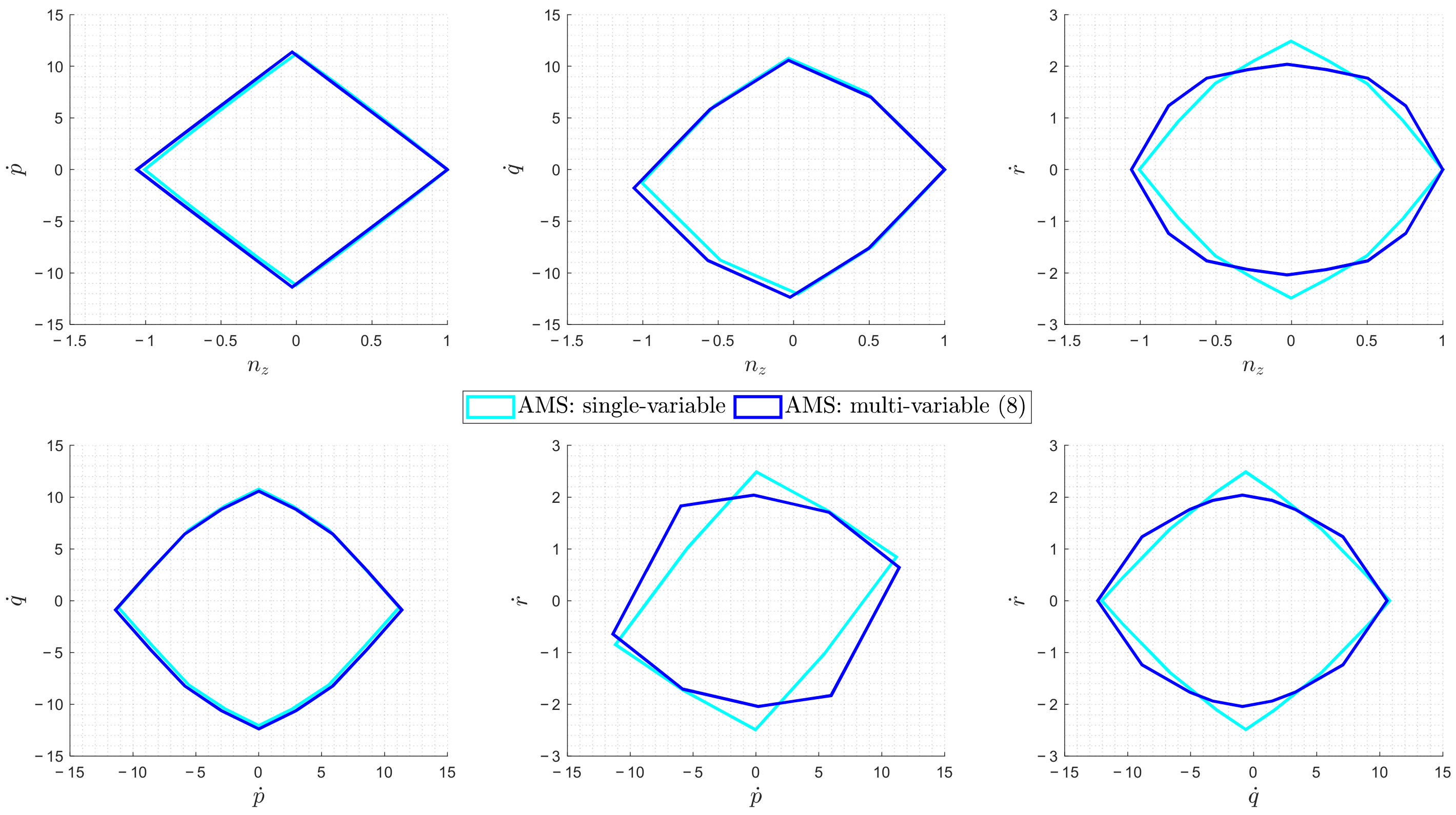
| Initial State | Single-Variable Optimization | Multi-Variable Optimization | |
|---|---|---|---|
| Parameter Vector (Angles in degree) | |||
| Cost Function | 17.2 | 13.7 | 13.2 |
| Nonlinear Constraint (Condition Number) | 11.25 | 2.9 | 5.4 |
Publisher’s Note: MDPI stays neutral with regard to jurisdictional claims in published maps and institutional affiliations. |
© 2021 by the authors. Licensee MDPI, Basel, Switzerland. This article is an open access article distributed under the terms and conditions of the Creative Commons Attribution (CC BY) license (https://creativecommons.org/licenses/by/4.0/).
Share and Cite
Zhang, J.; Söpper, M.; Holzapfel, F. Attainable Moment Set Optimization to Support Configuration Design: A Required Moment Set Based Approach. Appl. Sci. 2021, 11, 3685. https://doi.org/10.3390/app11083685
Zhang J, Söpper M, Holzapfel F. Attainable Moment Set Optimization to Support Configuration Design: A Required Moment Set Based Approach. Applied Sciences. 2021; 11(8):3685. https://doi.org/10.3390/app11083685
Chicago/Turabian StyleZhang, Jiannan, Max Söpper, and Florian Holzapfel. 2021. "Attainable Moment Set Optimization to Support Configuration Design: A Required Moment Set Based Approach" Applied Sciences 11, no. 8: 3685. https://doi.org/10.3390/app11083685
APA StyleZhang, J., Söpper, M., & Holzapfel, F. (2021). Attainable Moment Set Optimization to Support Configuration Design: A Required Moment Set Based Approach. Applied Sciences, 11(8), 3685. https://doi.org/10.3390/app11083685







